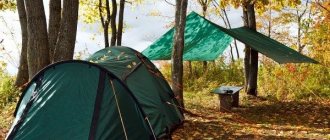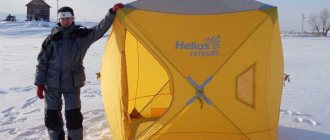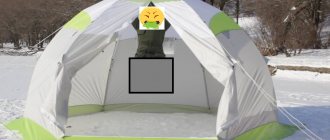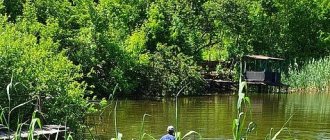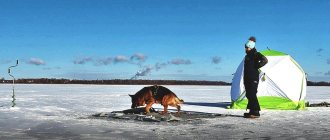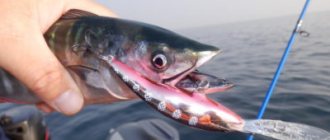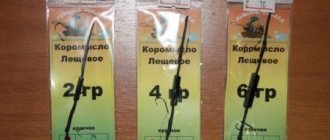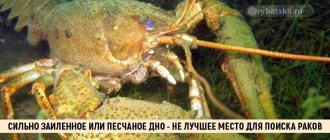Correct location
First, the shelter must be secured to the ice, into which large screws are screwed or metal pins are driven in. The tent is attached to them using special tension loops.
A tent for winter fishing should be positioned in such a way as to protect it as much as possible from cold air. Before installation, determine the wind direction. The shelter is positioned so that the entrance to it and the ventilation hole are on the leeward side. The bottom of the tent is sprinkled with snow to provide stability.
This will provide preliminary protection against the cold.
Insulation methods and materials for insulation
The tent must be insulated all around - inside and out. Materials are available and do not require large expenses. Now there are winter versions of tents on the market, but if you already have one, why buy a new one if you can insulate it yourself.
Insulating the top of the tent
The tent is insulated on top to provide additional protection from precipitation and wind. The easiest way is to use plastic film. It should be tight. The tent is covered with material and secured using office clips. From below you need to press down the polyethylene with snow or pieces of ice. Film shelter makes the tent 3-4 times warmer.
The second popular material is the fabric of an old Soviet tent. It is breathable and dense. It’s better to make a cover out of it and put it on top of the dome. Tarpaulin or Oxford protects well from the wind. With such insulation, the tent will not blow out and it will not get wet. Both of these methods increase the thermal insulation properties of the shelter by 4-6 times.
Film cover makes the tent 3-4 times warmer
It is not difficult to insulate using an awning, the main thing is that it covers a single-layer tent by at least 70%. It is preferable to make a cover that simply fits onto the structure.
Internal insulation
Insulating a winter tent from the inside is essential for harsh climates. This prevents condensation from accumulating and turning into ice. You can purchase special material or make a coating to insulate your tent yourself.
The simplest method is to insulate the walls with an old blanket. This option will not be enough for a long time, but for a slight frost, together with external insulation, it is quite enough.
A budget-friendly way is to take padding polyester or batting and staple foil onto it. You need to quilt the material in this way as often as possible so that the foil fits securely to the base. The result is a fabric with heat-reflecting properties. It is fixed to the frame using office clips. The foil layer should be positioned facing the inside of the tent so that the heat from the person and the heater does not escape anywhere.
To achieve maximum insulating effect in winter, it is better to take a ready-made specialized material - Izolon. The minimum thickness is 2mm. It is plastic, durable, and does not rot, which guarantees its reusable use as winter tent insulation. The material is made of foamed polymer with a foil coating. An analogue is Penofol, which also has reflective properties. They have one drawback - the high price.
Isolon - the inner insulation of a tent
Internal insulation of the tent will allow you to retain 6-8 times more heat.
The choice of material depends on the planned time of winter fishing. If it is planned for several days, then you need to buy professional thermal insulation.
Floor insulation
Thermal insulation for the tent floor can be selected from the following materials: camping mats, insulation or thick felt. They are easy to transport in a car when rolled up. The insulation is simply laid in one or several layers. Rugs and isolon are based on foamed polymer, which holds heat well. Felt warms due to wool.
You can insulate the floor with thick felt
It is necessary to take into account that from prolonged use the snow and ice under the heat insulator will melt and a puddle will form. Therefore, the bottom layer needs to be polyethylene.
How to make a tent for winter fishing with your own hands
You can make a tent for winter fishing yourself, but when selecting the optimal material, you should first pay attention to the following aspects:
- the resulting tent should be light, compact and mobile, which will make it easier to move when choosing the best place for fishing;
- the covering material is dense and waterproof (for example, tarpaulin);
- the design is easy to install and unfold;
- the elements are made of light and durable material (for example, it is better to replace the plastic frame with aluminum);
- The tent should keep the heat inside.
Video: how to make a winter tent
Tent drawing
Depending on the chosen model, tents can have different shapes and designs. Thus, the structure can be stationary (in the form of a house) and require assembly every time the fisherman moves from place to place. Or be placed on skis, which will make it possible to easily move the shelter without having to assemble it and install it again each time.
Choosing tent material
In the process of making homemade covering structures, it is allowed to use a variety of materials. Most often they are thick fabrics or polyethylene, or they use the material of an old tourist tent. For more stable structures, plywood can be used. The choice will depend both on the fisherman’s personal preferences and financial capabilities. Many people make their own tents from materials that can always be found in the garage or storage room, without resorting to additional expenses.
Did you know? The largest fish caught on the line was a white shark. This event occurred in the late 50s of the last century, and the weight of the catch was 1,208 kg.
Made from polyethylene
Polyethylene is one of the most affordable materials.
The design of such a tent is easy to implement and can have several types:
- The simplest case involves the absence of a frame, and a drill stuck into the ice or an ice pick can be used as a stand. The upper part of the material is sewn together, and the lower part is folded inward and secured with any heavy objects. This type of product is low cost and easy to install. However, there are also disadvantages: the inconvenience of fishing with active hooking and a low level of protection from wind and precipitation.
- There is also a more complex design option using plastic pipes as a frame. During production, additional materials will be required - connecting elements and a soldering iron. The polyethylene film should have the following dimensions: one side - 3 m, the other - 4 m. This segment is given the shape of a triangle or quadrangle (optional). For a pyramidal frame, plastic pipes are soldered in the form of two triangles, the installation of which is carried out from the ends. At the same time, the main parts of the figure are connected using adapters (i.e., in the end result, one side of the pipe is soldered to the desired element, and the second is inserted into the other). The point where the tent parts intersect (the top of the structure) should be additionally secured with rope.
From skis or sleds and an awning
This design is a time-tested shelter used by many ice fishing enthusiasts.
Important! If the tent is moved in strong wind conditions, the windage level can be reduced by removing the awning.
The instructions for making such a shelter consist of several main steps:
- The frame is made up of vertically positioned ski poles, and the horizontally (at the top) are plastic or aluminum tubes. In the corners, the structure is connected using tees of the required size.
- Ski poles are attached to the skis themselves, to which metal plates are screwed and a tongue located at the bottom of the poles is inserted. In order to secure this mechanism, the stick is rotated 90°.
- The connecting element between the fishing box and the frame are tubes that bend and attach the latch on one side and the clutch on the other.
- The box and tubes are connected using a spring made of copper strip.
- The structure is covered with an awning, and at the bottom the covering material is secured using holes prepared in the fabric (staples installed along the edges of the skis are threaded through them). The stability of the entire structure is provided by several weights attached to the tent.
From fabric
A tent can also be built from any fabric suitable for these purposes. The capacity of this tent is 1-2 people.
For production you will need:
- water-repellent material - 12–14 m²;
- metal washers (diameter - 1.5 cm) - 20 pcs.;
- strong cable - 12–15 m;
- tape (narrow) - 9–10 m;
- material with a rubberized base - 6–7 m.
We recommend reading about how to make a winter fishing rod with your own hands.
The assembly process itself consists of several stages:
- Prepare two pieces of fabric (size - 1.8 × 1 m), markings are made on each side at a distance of 65 cm from each other. An incision is made at the junction, which will serve as the entrance to the tent and the back wall.
- All elements are carefully stitched, additionally strengthening the seams with tape.
- To make it possible to tightly fasten the fabric at the entrance, metal rings are pre-sewn into it.
From a tourist tent
If a fisherman has a tourist tent at his disposal, it can easily be used as shelter during winter fishing. To do this, simple modifications are used. For example, if there is a bottom in the tent, a special cutout is made in it for access to the hole (it can also be equipped with a zipper, which will significantly increase convenience). Moreover, such a tent can be used not only in winter, but also in other seasons for its intended purpose.
The nuances of forced heating
When the tent is insulated from the outside and inside, you need to think about heating. Device options:
- Alcohol burner. It is light and economical, but produces little heat.
- Paraffin candle. It will help in a small one-person tent in mild frost. The flame is directed upward, and all the heat is concentrated there. For normal heating you will need 10 candles. The downside is the high fire hazard. You will have to watch the candles all the time so that they do not fall and set the tent on fire.
- Dry fuel. There are so-called “dry alcohol tablets”. They can be used, but you will have to be distracted every 15 minutes to ignite a new tablet. The advantages are the absence of odor and soot.
- Gas lamp. Recharges with propane. It provides little heat and is only suitable for mild frosts.
- Gas heater. There are many different modifications. The simplest is “Pathfinder” with a power of up to 2 kW and a flow rate of up to 110 g/h. Weighs only 370 grams and can heat a room up to 20 sq.m.
- Gas burner with infrared radiation. Connects to a gas cylinder with a capacity of 5-50 liters. Power from 1.45 kW, consumption from 100 g/h. You can cook food on this device.
- Catalytic heating pad for individual heating. Placed on clothing. Portable device charged with highly purified gasoline. Safe device with a minimum flow rate of 20 ml/hour. Battery life -16 hours.
- Gas infrared heater "Solyarogaz". Budget device with good power. Quickly heats up a small tent space.
- Gasoline Primus tourist. Allows you to cook food and heat water, while warming the tent. Not suitable for heating separately.
- Mini solid fuel stove. Runs on coal or wood. The pipe must be routed outside the tent. Use for short-term winter fishing is not justified. You need to take fuel with you and build an outlet for the pipe.
When using any type of heater, there is a mandatory condition - the tent must have a ventilation hole.
Otherwise, there is a risk of poisoning from combustion products. Gas appliances have a big disadvantage - in severe frosts the gas freezes, so the tent must be properly insulated. In addition, you need to take a gas cylinder with you.
In addition to modern ones, there are old methods that fishermen have used since ancient times:
- Hot stone. A large stone is heated over a fire, wrapped in several layers of foil and placed on a board in the tent. The heat generated will last for about 6 hours. Difficulties - you need to make a fire and look for a stone.
- Boiling water. A bucket of water is heated, closed tightly and placed on a stand. Heating will last for 4 hours. The main thing is not to forget about the dangerous object and not get burned.
Of course, improvised heaters will not be enough for the entire frosty night. For a short time, you can get by with these available means.
Warm floor for winter tents Cube
Section size 2.35 x 1.2 meters. Designed for insulating winter tents Cube square and rectangular shapes from any manufacturer. Using linden, sections can be connected to each other to the required size. This heated floor is also used for camping sauna tents and vestibules produced by PF Bereg.
The insulated tent floor has a “sandwich” design and consists of several layers:
First layer
Oxford fabric 300 with water-repellent impregnation 4000 mm. The density of the fabric allows for maximum wear resistance, and the impregnation makes the fabric airtight and protected from leaks during moderate rainfall.
Second layer
Foil-coated isolon 6 mm thick. The presence of foil in the insulation allows you to reduce heat loss at the site where the tent is installed, as well as retain heat inside the residential module.
Advantages of foil isolon as a material for heated floors in a tent:
- Low density, light weight of the material;
- High sound absorption;
- Reflects up to 97% of thermal radiation;
- Vapor permeable, the material “breathes”;
- Operating temperature of use is from +70 to -60°C.
Third layer
Oxford fabric 300 with water-repellent impregnation 4000 mm. Duplicates the first layer of a warm floor and makes it possible to lay it on any side. The choice of Oxford material for insulating the tent floor is due to the easy cleaning of the fabric and quick drying.
The first and third layers are responsible for the moisture resistance of the product, foil insulation is responsible for heat retention. This combination of materials combines the most effective and affordable way to insulate a winter tent with the floor.
The insulated winter floor will fit Cube tents from most manufacturers (Bullfinch, Bear, Stack, Lotus)
